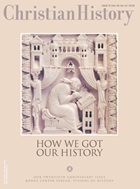Backstage passes. Insider accounts. "The making of." As much as people enjoy the show, whatever it may be, they seem to have a quenchless desire to peek at the gears and switches, to uncover the messiness behind the polished product. That's what this issue—our twentieth anniversary issue—is about.
The technical term for studying "the making of" history is historiography. This discipline is less interested in historical events than in the people who recorded them—their backgrounds, their biases, the tools they used and the way they used them. Where history examines the hand holding the sword, historiography examines the hand holding the pen.
Historiography matters at the professional level because historians want to know how their craft has evolved. But the subject matters to casual readers of history, too, because we all take accounts of the past on faith. With history, as with rumors and recommendations, it's crucial to consider the source.
Christian History has never broached quite so technical a subject. In 20 years of publishing, we've mostly focused on stories—biographies, narratives, firsthand reports. We ask our writers, most of whom are professional scholars, to drop footnotes and add anecdotes, to skip the heavy theoretical questions and cut to the chase.
This approach grew naturally out of the vision of the magazine's founder, Ken Curtis: "to acquaint readers with significant events, personalities, movements and developments in the history of the church." The same vision drives Ken's work at Gateway Films. Originally, the magazine and the videos went together.
(That, in case you've ever wondered, is why issue 1 covered not Augustine or Martin Luther, but Zinzendorf and the Moravians. Ken had just finished a film on the Count and his crew.)
Ken's vision has served us well over the years. Features such as the Timeline, the Gallery, and "Did You Know?" have been around from the beginning, as have a few of our contributors and editorial advisers (and subscribers!). We still tackle just one topic per issue.
By treading lightly on theory, however, we've left out one important piece from our presentation of history: a primer on the critical lenses readers should wear at all times. Like the bucket of 3-D glasses in a theater lobby, this issue provides those critical lenses, then offers primary sources on which you can try them out.
Can you spot Eusebius's pro-Roman leanings? A hagiographer's doubts? Hieronymous Bosch's worldview? Anabaptist self-identity? Have a little fun with historiography.
Copyright © 2001 by the author or Christianity Today/Christian History magazine.
Click here for reprint information on Christian History.

Support Our Work
Subscribe to CT for less than $4.25/month



























